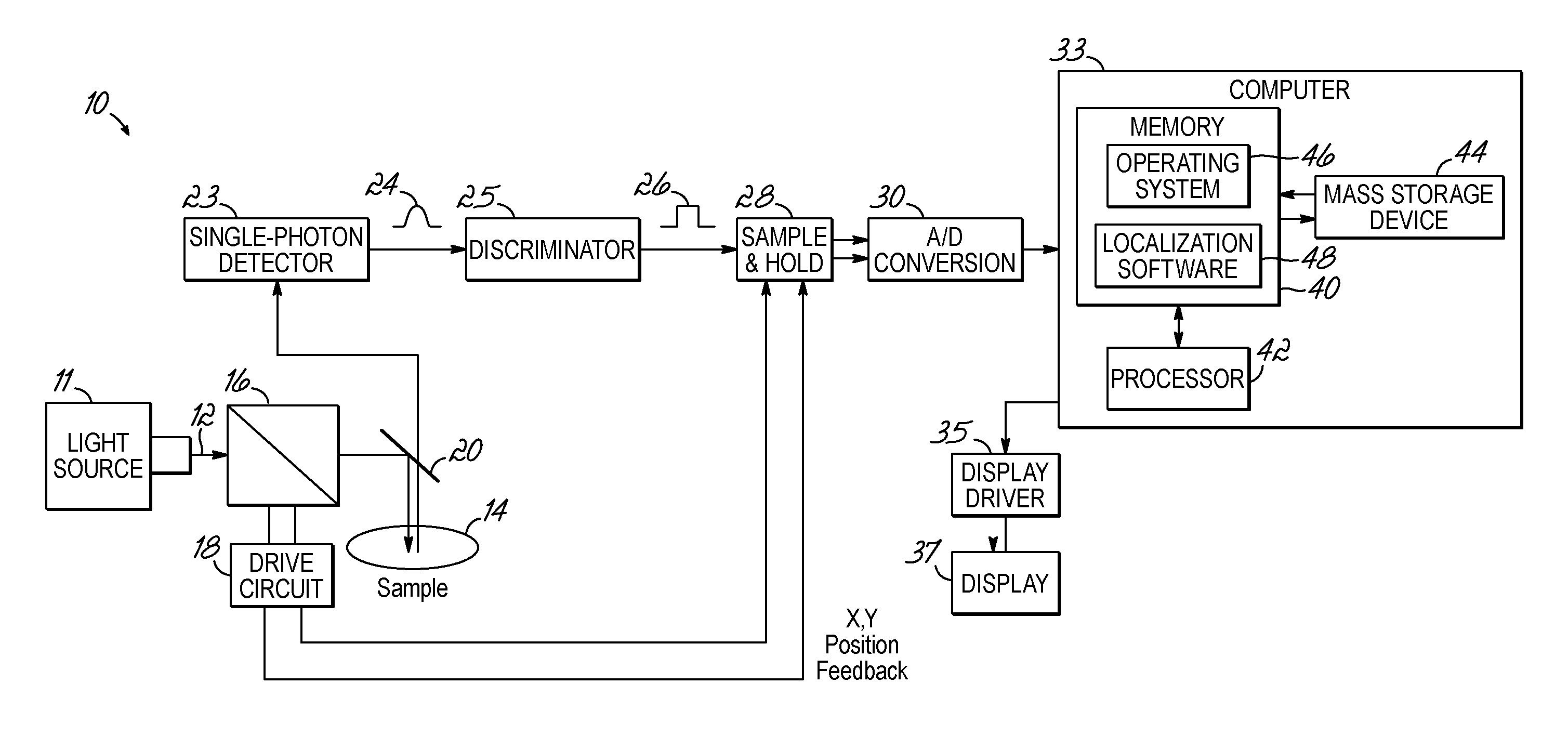Method, system, and computer program product for localizing photons and a light source emitting the photons
a technology of light source and localization method, applied in the field of localization method, system and computer program product, can solve the problems of insufficient standard statistical methods for localizing spatial coordinates, adverse effects on confidence in the knowledge of (x,y) position, etc., and achieve high spatial and temporal resolution, high resolution, and high localization uncertainty
- Summary
- Abstract
- Description
- Claims
- Application Information
AI Technical Summary
Benefits of technology
Problems solved by technology
Method used
Image
Examples
example 1
[0067]Fluorescent beads (Dragon Green 488 / 520 excitation / emission, Bangs Laboratories, Inc., Fishers, Ind.) with a diameter of ninety-two (92) nanometers were selected as a sub-diffraction light source to approximate single fluorophores. These fluorescent beads produced images of diffraction-limited spots defined by the point spread function (PSF) of the optical system. The fluorescent beads were mounted in glycerol on cleaned cover slips. The fluorescent beads adhered to the cover slip and remained immobile throughout image acquisition. With one exception, images were acquired at two (2) frames per sec, using a raster scan pattern, from a region of the specimen roughly 2.2 microns×2.2 microns. During acquisition, the focal plane was maintained constant using a focus control system (C-focus, Mad City Labs, Inc., Madison, Wis.).
[0068]High-resolution light microscopy images are typically formed by binning photons into pixels sized 2.3 times smaller than the maximum resolvable spatial ...
example 2
[0074]This example demonstrates the localization error due to Gaussian fitting. The location of a single fluorescent particle can been determined for the purpose of tracking single molecules by statistically fitting a Gaussian intensity profile to a COP image of the spot. Under ideal conditions, with no background noise (i.e., b=0), the predicted uncertainty of localization for Gaussian fitting depends only on: 1) the width of the spot, which depends on the wavelength of light used and the numerical aperture of the objective lens; 2) the number of photons collected; and 3) the size of the pixels used to form the image. Under ideal conditions, the predicted uncertainty of multi-variate distribution localization is obtained by measuring the width (one standard deviation) of the particle location PDF that results from the multi-variate distribution localization equation.
[0075]With reference to FIG. 3C, the predicted uncertainty of localization, plotted as a function of photon count, fo...
example 3
[0080]This example relates to the precision of localization using a multi-variate distribution localization approach in acquired images.
[0081]Small changes in focus can have considerable effects on the width and shape of the spot and, therefore, on localization results. To test whether a focal plane could be identified consistently during localization experiments, the focal planes of twenty (20) different sub-diffraction (92 nm) beads were determined prior to image acquisition, based on the sharpest image and highest photon count. An image sequence was captured of each bead and, post acquisition, the width of a Gaussian intensity profile fit to a COP image of the bead was measured in 30 sequential frames. The average of the 30 measurements for each of the 20 beads is reported as a mean spot width (open circles) in FIG. 4A. During image acquisition, each bead displayed good radial and bi-axial uniformity as focus was changed, indicating the presence of only minor spherical aberration...
PUM
 Login to View More
Login to View More Abstract
Description
Claims
Application Information
 Login to View More
Login to View More - R&D
- Intellectual Property
- Life Sciences
- Materials
- Tech Scout
- Unparalleled Data Quality
- Higher Quality Content
- 60% Fewer Hallucinations
Browse by: Latest US Patents, China's latest patents, Technical Efficacy Thesaurus, Application Domain, Technology Topic, Popular Technical Reports.
© 2025 PatSnap. All rights reserved.Legal|Privacy policy|Modern Slavery Act Transparency Statement|Sitemap|About US| Contact US: help@patsnap.com



